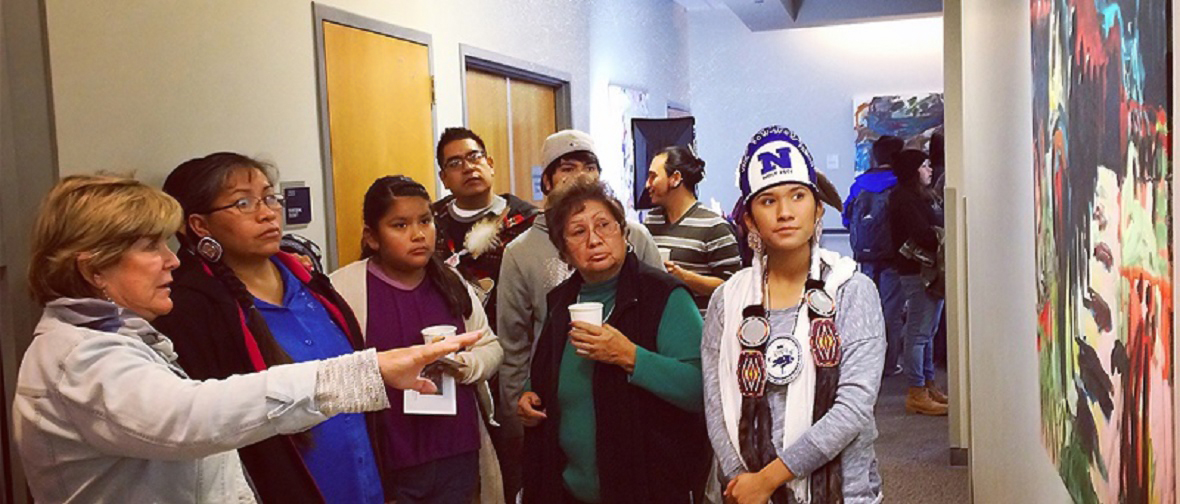From development of strategies to deal with climate change on tribal lands to the careful archiving of papers detailing a long legal battle over Shoshone grazing rights, the University is becoming more closely engaged with Native American and tribal peoples. The engagement involves a wide swath of the University - from Cooperative Extension programs to its art galleries and from its hydrology- and agricultural-research teams to its Center for Student Cultural Diversity.
The timing of four current, campus exhibits intersects in November, which is highlighted nationally as Native American Heritage Month. Programming included a Nov. 13 presentation by Nancy Mithlo, chair of American Indian Studies at the Autry Museum of the American West in Los Angeles.
"From my perspective as a native person who went on to college, it is significant to see things that are representative of your culture on campus," Saundra Mitrovich, outreach and retention coordinator in the University's Center for Student Cultural Diversity and a Native American enrolled with Northern California's Tyme Maidu Tribe, said.
Mitrovich was named Nevada's American Indian Youth Services/Role Model of the Year at the 2015 American Indian Achievement Awards Banquet at the Governor's Mansion on Nov. 14. A first-generation college student herself, Mitrovich focuses on outreach, retention and success of all students, although with a special emphasis on working with the 27 tribes in Nevada.
She recognizes that exhibits such as those now on campus foster greater cultural understanding. "It is not just embedded in the past," she said of native culture. "We are a people that live and breathe today and into the future. These programs can reframe the view of Native Americans."
Patricia Mills: "Catching Shadows"
The photography of Edward Curtis and his Native American subjects in the late 1800s and early 1900s left artist Patricia Mills "compelled to create my own interpretation of these images."
"Edwards wanted his work to represent an overview of Native American life, not a specific microcosm of one group of people or tribe," Mills wrote on her website. "I have attempted to carry on this desire of Curtis' vision with a view of the 21st Century."
A collection of Mills' colorful, impressionistic paintings is on exhibit on the third floor of the Joe Crowley Student Union through March 2016.
Traditional duck decoys exhibited
Joe Allen, who crafts tule duck decoys using 2,000-year-old traditional techniques developed by Nevada's native peoples, shares more than a dozen of his recent decoys in an exhibition at Sheppard Contemporary Gallery, in the Church Fine Arts building, that runs through Jan. 22.
Allen uses skills he learned through an extended apprenticeship with master-maker Martin George, who, in turn, comes from a long line of makers. The decoys are created only from cattail and tule reeds harvested around Stillwater and Fallon, Nev. University Galleries is purchasing two decoys from Allen's exhibition for its permanent collection.
Emily Arthur: "Endangered"
"Endangered," an exhibition by Emily Arthur at Sheppard Contemporary Gallery through Jan. 22, provides a commentary on the history of expansion and government regulation that has changed the lives of American Indians over the last two centuries.
An artist currently teaching in the nation's top printmaking program at the University of Wisconsin-Madison, Arthur worked with scientists at Occidental College in Los Angeles to investigate the ongoing controversy surrounding the coastal California population of the gnatcatcher, a bird that lives across the United States.
"I seek the unbroken relationship between modern culture and ancient lands which uses tradition and story to make sense of the enduring quest to understand our changing experience of home," the artist said.
A special collection of historic documents
The historical treasure represented by the papers of two Shoshone sisters who took on the federal government over grazing rights are on exhibit through March at the Mathewson-IGT Knowledge Center Special Collections.
The papers were donated by Carrie Dann, who joined with her sister, Mary, in a decades-long, but unsuccessful, legal battle to affirm tribal grazing rights in the Ruby Valley of northeastern Nevada. The case ultimately was decided by the U.S. Supreme Court.
Mary Gibson, a cousin to the Dann sisters, spent a year cataloging and archiving the 120 cartons of documents through a grant from the National Historical Publications and Records Commission.
Outreach and research into tribal communities
In addition to the programs and exhibits on campus, research and outreach initiatives are extended into tribal communities:
- Climate resiliency in focus: Native Waters on Arid Lands, a research and outreach program based at the University, seeks to increase the resiliency of tribal communities in the Great Basin and American Southwest as they face the effects of climate change. The project, which kicked off with a Tribal Summit in Las Vegas in early November, brings American Indian farmers and ranchers, natural resource managers and tribal communities together with university researchers to explore factors ranging from the ways that ancient communities dealt with climate change to the modern-day costs of adapting to climate change.
- Beginner farmers supported: For a quarter of a century, staff members of the University of Nevada Cooperative Extension have helped Native American farmers and ranchers - especially those who are just starting out - become more skillful. The Beginning Farmers and Ranchers Project, as well as the Federally Recognized Tribes Extension Program, provide training for hundreds in subjects such as financial management, entrepreneurship and marketing and basic farming and ranching skills.
- Veggies for Kids program: Nevada elementary school students at Paiute and Shoshone reservations, and in schools in nearby communities, learn about healthy eating and the value of native foods through a program overseen by Cooperative Extension since 2000. Students in second- and third-grade classes grow their own food in school gardens, learn about native foods and benefit from in-school nutrition classes. Hoop houses at the schools, meanwhile, produce fresh produce even after traditional growing seasons end. Six schools in Hawthorne, Lyon, Elko and Washoe counties participate.











